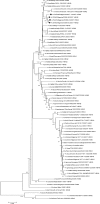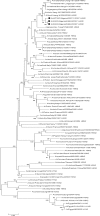Evidence of infection by H5N2 highly pathogenic avian influenza viruses in healthy wild waterfowl
- PMID: 18704172
- PMCID: PMC2503949
- DOI: 10.1371/journal.ppat.1000127
Evidence of infection by H5N2 highly pathogenic avian influenza viruses in healthy wild waterfowl
Abstract
The potential existence of a wild bird reservoir for highly pathogenic avian influenza (HPAI) has been recently questioned by the spread and the persisting circulation of H5N1 HPAI viruses, responsible for concurrent outbreaks in migratory and domestic birds over Asia, Europe, and Africa. During a large-scale surveillance programme over Eastern Europe, the Middle East, and Africa, we detected avian influenza viruses of H5N2 subtype with a highly pathogenic (HP) viral genotype in healthy birds of two wild waterfowl species sampled in Nigeria. We monitored the survival and regional movements of one of the infected birds through satellite telemetry, providing a rare evidence of a non-lethal natural infection by an HP viral genotype in wild birds. Phylogenetic analysis of the H5N2 viruses revealed close genetic relationships with H5 viruses of low pathogenicity circulating in Eurasian wild and domestic ducks. In addition, genetic analysis did not reveal known gallinaceous poultry adaptive mutations, suggesting that the emergence of HP strains could have taken place in either wild or domestic ducks or in non-gallinaceous species. The presence of coexisting but genetically distinguishable avian influenza viruses with an HP viral genotype in two cohabiting species of wild waterfowl, with evidence of non-lethal infection at least in one species and without evidence of prior extensive circulation of the virus in domestic poultry, suggest that some strains with a potential high pathogenicity for poultry could be maintained in a community of wild waterfowl.
Conflict of interest statement
The authors have declared that no competing interests exist.
Figures



References
-
- Olsen B, Munster VJ, Wallensten A, Waldenstrom J, Osterhaus AD, Fouchier RA. Global patterns of influenza a virus in wild birds. Science. 2006;312:384–88. - PubMed
-
- Röhm C, Horimoto T, Kawaoka Y, Suss J, Webster RG. Do hemagglutinin genes of highly pathogenic avian influenza viruses constitute unique phylogenetic lineages? Virology. 1995;209:664–670. - PubMed
-
- Alexander DJ. A review of avian influenza in different bird species. Vet Microbiol. 2000;74:3–13. - PubMed
Publication types
MeSH terms
Associated data
- Actions
- Actions
- Actions
- Actions
- Actions
- Actions
- Actions
- Actions
- Actions
LinkOut - more resources
Full Text Sources
Medical
Research Materials
Miscellaneous

